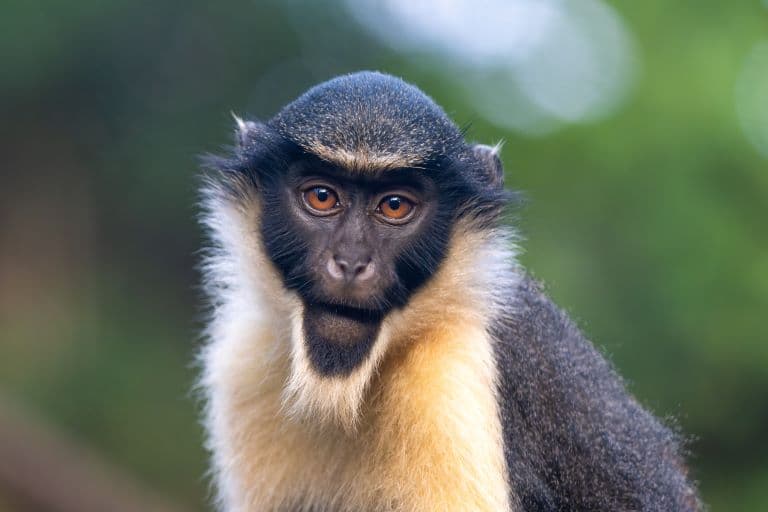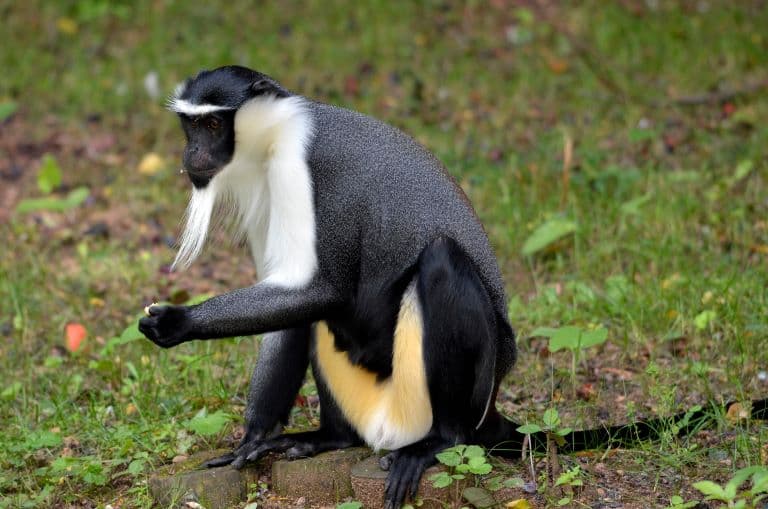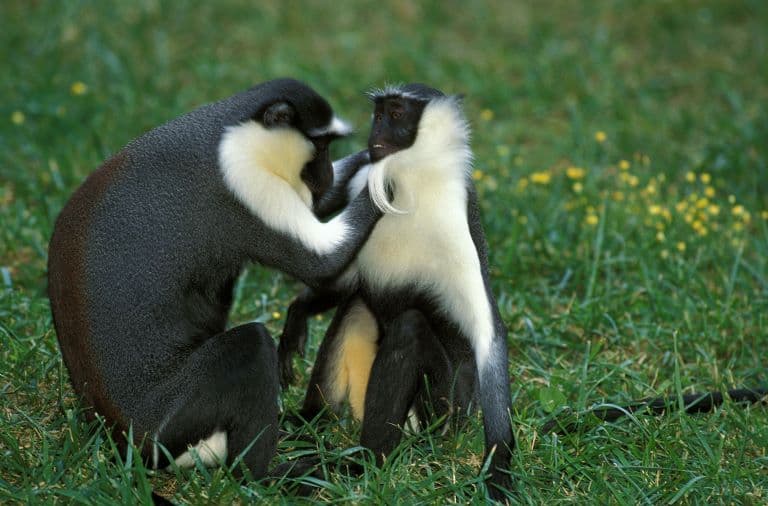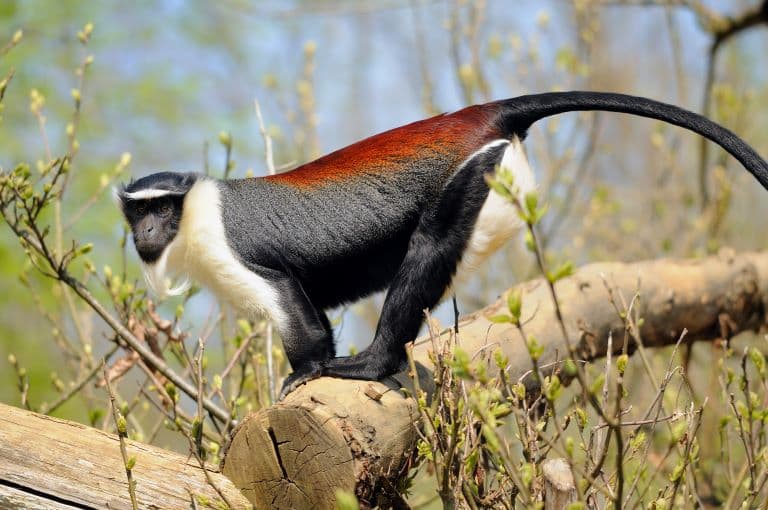Diana Monkey Profile
In Ancient Rome, as the Romans often did, a Goddess was commandeered from the previous Hellenistic religions; valued for her role as a patroness of the countryside and nature, hunters, wildlife, childbirth, crossroads, the night, and the Moon, Diana was often depicted with a quiver of arrows, elegant, draped clothing and of course the characteristic nip-slip that was so popular during the period.
So, perhaps in a grotesque tribute to this poor deity, around 1800 years on, a species of Old-World monkey, and known vector of yellow fever and tuberculosis, was named after her. Not because of any of the virtues they share, but because people think she happened to look a bit like one.

Diana Monkey Facts Overview
| Habitat: | High canopy forests, primary and old secondary forest |
| Location: | West Africa: Sierra Leone, Liberia, and western Côte d’Ivoire |
| Lifespan: | 20 years in the wild, up to 37 in captivity |
| Size: | 55 cm (22 in) long with a 75 cm (30 in) tail |
| Weight: | Up to 7kg (15 lb) |
| Colour: | Variable, mostly black, with a white throat, ruff and back of arms, reddish thighs |
| Diet: | Fruit, flowers, leaves, insects |
| Predators: | Raptors, snakes, leopards, chimps, humans |
| Top Speed: | Not reported |
| No. of Species: | 1 |
| Conservation Status: | Endangered (IUCN) |
To their (and the deity’s) credit, Diana monkeys are quite good-looking. Perhaps not to the level of the Gods, but they do have some charm.
They’re medium-sized guenons, a genus of Old-World monkeys found over much of Equatorial Africa. This species is heavily restricted to the Western coast, and still in decline as a consequence of its very particular habitat needs, and the continued destruction of these habitats.
But this is a clever and adaptable species, and with a little help, they could well be saved.
Interesting Diana Monkey Facts
1. They’re guenons
Monkeys are generally grouped into the New World and Old World species. Pretty much every monkey that isn’t native to the Americas is an Old World monkey, from the Cercopithecidae family.
This includes all African and Asian species, and all of these monkeys are more closely related to apes than they are to the five families found in Mexico and South America.
Diana monkeys are a genus within this family, native to sub-Saharan Africa, called Cercopethicus.
This genus contains 19 species including some of the largest arboreal monkeys in Africa like the Blue monkey. Together, they’re known as the guenons, and Diana monkeys are characteristically large and quite pretty animals.

2. Their young are strong
From birth, baby Diana monkeys have their eyes open and enough grip strength to hold onto their mothers’ fur.
Their mothers look after them for about six months, during which tactile communication is an important part of their bonding. After this, adolescent males are strong enough to go it alone and the females will stick around for life.
These are very social monkeys, hanging out in groups of up to 30 females with a single male.
They have very pronounced facial features and expressions which are used for intricate communications and alongside this are a set of vocalisations that serve multiple purposes from alarm to appeasement. 1
3. They’re public servants
This species is known to be quite vocal in the forest, and its communication isn’t limited to members of its own species.
Females are particularly noisy and express themselves quite clearly to family members and other animals alike.
They have a specific call for each threat, which allows animals around them to understand exactly what they’re shouting about, and forms a vocabulary of calls that’s far more advanced in the females than it is in the males.
At least one bird, the yellow-casqued hornbill, along with other monkey species, is smart enough to have learned this language, so love to hang out with the Diana monkeys for added safety.

4. Females warn early
The single male in a group appears to be a bit slow on the draw when it comes to these alarm calls.
Researchers showed that adult females are almost always the ones to initiate territorial bouts, suggesting that they’re in charge of setting the boundaries.
Females are not shy to scrap, either, and have been known to kill one another, using their canines as weapons – a behaviour more commonly associated with male primates, and remains the first and perhaps only record of this happening in guenons. 2
5. They’re learning to avoid poachers
Leopards and raptors are common threats to arboreal monkeys like this, but there is the ever-increasing presence of poachers to consider, too.
When this species hears or sees humans, it makes no alarm call. Instead, they remain silent, hiding in the canopy or moving away quietly.
But the poachers, having also learned the monkeys’ language imitate the calls to action, screaming the alarm calls for a leopard or eagle. This triggers widespread alarm calls and panic, alerting the poachers to the locations of the monkeys.
This approach seems to work for a while, but the monkeys quickly learn to differentiate between the real calls and the lame human impressions in regions where they are repeatedly exposed to both.
Unfortunately, this discrimination ability can be lost as quickly as it’s acquired, so groups of monkeys who have spent a generation away from poachers will have to learn the hard way to avoid them. 3
6. They’re a primary forest species
This species has a very limiting preference for its habitat. It is a primary forest specialist, unable to thrive in secondary, or recovering forests. It is occasionally found in old secondary forests, but its range now is severely limited almost exclusively to coastal areas. 4

7. This is a problem
The narrow band of viable habitats for this species mean that they are in serious trouble. Hunting, mining and habitat encroachment combine with deforestation of ancient woodland to restrict this poor monkey to a very small region.
They are now heavily protected by CITES and listed as Endangered by the IUCN, and mostly found in protected areas.
Diana Monkey Fact-File Summary
Scientific Classification
| Kingdom: | Animalia |
| Phylum: | Chordata |
| Class: | Mammalia |
| Order: | Simiiformes |
| Family: | Cercopithecidae |
| Genus: | Cercopithecus |
| Species: | diana |
Fact Sources & References
- Karen Kennedy, “Cercopithecus diana Diana monkey”, Animal Diversity Web.
- W. Scott McGraw (2022), “Adult Female Cercopithecus diana Employ Canine Teeth to Kill Another Adult Female C. diana”, Springer Nature Link.
- Redouan Bshary (2001), “Diana monkeys, Cercopithecus diana, adjust their anti-predator response behaviour to human hunting strategies”, Springer Nature Link.
- “Diana Monkey”, IUCN Red List.
